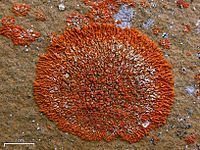
Photo from wikipedia
Abstract In China, cucumber plants suffer chilling stress during the winter and early spring, and grafting would help the plants adapt to chilling stress. Pumpkin (Cucurbita moschata; 2n = 40) is an… Click to show full abstract
Abstract In China, cucumber plants suffer chilling stress during the winter and early spring, and grafting would help the plants adapt to chilling stress. Pumpkin (Cucurbita moschata; 2n = 40) is an important rootstock for cucumber (Cucumis sativus L.) grafting. However, there are no published molecular genetic studies of chilling tolerance in pumpkins used as rootstock. An F2 population with 166 individuals was derived from a cross between a chilling-stress-susceptible high-generation inbred line (‘5-5-6′) and a chilling-stress-tolerant high-generation inbred line (‘8-3-7′). The chilling index (CI) was used to evaluate the cold tolerance of the parental lines and the F2 population. The continuous and normal distribution of the CI in the F2 population suggested that the trait of chilling tolerance was a typically quantitative trait controlled by multiple genes and was suitable for quantitative trait loci (QTL) mapping. A molecular linkage map was constructed using 95 simple-sequence repeat (SSR) markers, resulting in 15 linkage groups (LGs) covering a total distance of 830.7 cM with an average interval of 8.74 cM. Three QTLs were detected for CI, explaining 0.30%, 1.22% and 20.88% of the phenotypic variation. The genetic map and QTLs will serve as framework for future molecular breeding studies.
Journal Title: Scientia Horticulturae
Year Published: 2017
Link to full text (if available)
Share on Social Media: Sign Up to like & get
recommendations!